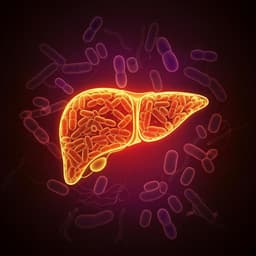
Earth Sciences
High precipitation rates increase potassium density in plant communities in the Tibetan Plateau
X. Li, M. Li, et al.
Discover the intriguing findings of a study conducted by Xin Li, Mingxu Li, Xiaoyu Cen, Li Xu, and Nianpeng He, which examined potassium content across 2,040 Tibetan Plateau ecosystem communities. Learn how precipitation influences potassium levels and the implications for vegetation under climate change.
~3 min • Beginner • English
Introduction
Potassium (K) is the most abundant metal ion in plants and is critical for nutrient uptake, stomatal regulation, enzyme activation, and protein synthesis, yet systematic assessments of K in natural plant communities are scarce. The Tibetan Plateau (TP) provides a unique setting to study vegetation–environment interactions due to its high elevation, strong climatic gradients, diverse vegetation, and relatively low human disturbance. Prior large-scale ecosystem studies have emphasized nitrogen (N) and phosphorus (P), leaving significant gaps in understanding K distribution, allocation strategies among plant organs, and environmental controls at the community level. The study evaluates whether community-level K allocation follows optimal partitioning (environment-driven adjustments favoring resource-limited organs) or isometric partitioning (allocation governed by intrinsic plant traits and conserved scaling among organs). It also assesses the applicability of temperature-biogeochemistry and temperature-plant physiology hypotheses to K across environmental gradients in the TP, aiming to quantify K content, density, spatial patterns, drivers, and storage to inform ecosystem and Earth system models.
Literature Review
Historical work established K as essential for plant growth and physiological regulation. Large-scale nutrient studies have mostly focused on N and P, with limited community-level K research. Species-level or small-scale K studies emphasized K fertilizers and tolerance mechanisms but do not generalize to communities. Allocation theories include the optimal partitioning hypothesis (plants allocate more nutrients to the most resource-limited organs) and the isometric partitioning hypothesis (allocation driven by intrinsic plant characteristics with conserved allometric scaling). For spatial gradients, the temperature-biogeochemistry hypothesis posits colder conditions reduce soil microbial activity and nutrient availability, lowering plant nutrient content, whereas the temperature-plant physiology hypothesis anticipates higher plant nutrient content at low temperature to compensate for reduced physiological efficiency. These have been tested for N and P, with unclear applicability to K. Prior Chinese syntheses reported average leaf K but with variability due to climate, species composition, and methodology.
Methodology
Study area: The Tibetan Plateau (73.43°–104.67°E, 25.98°–39.82°N), average elevation >4,000 m, spans diverse topography and ecosystems (forests, shrublands, grasslands, deserts) and broad climate zones from tropical to frigid. Radiation ranges 11,277–17,581 kJ m−2 day−1; mean annual temperature (MAT) −6 to 20 °C; mean annual precipitation (MAP) ~20 to 3,042 mm increasing NW to SE. Sampling design: Systematic grid-based field sampling at 0.5° × 0.5° from July–August in 2019–2021. Four vegetation groups: forests, shrublands, grasslands, deserts. Total 2,040 natural plant communities: 507 forest, 66 shrub, 69 desert, 1,398 grassland. At each site, ≥3 plots with GPS coordinates and elevation recorded. Forest sites: three tree (20 m × 20 m), three shrub (5 m × 5 m), three herb (1 m × 1 m) quadrats; measured tree/shrub height and DBH; collected organs (leaves, branches, trunk cores ~4.3 mm, and roots excavated). Shrublands: shrub and herb quadrats sampled similarly. Grassland and desert plots: harvested all aboveground biomass in 1 m × 1 m squares; cored roots (9 cm auger) to 0–30 cm; aboveground and root biomasses recorded as leaf and root biomass; >70% of species per community sampled. Soil: 0–10 cm layer sampled for SOC, total N, total K, and pH. Laboratory analyses: Plant and soil samples washed, dried, ground (Retsch MM400 ball mill and RM200 mortar grinder). K content measured by ICP-OES (Optima Avio 500). SOC and soil N by elemental analyzer (Vario Max CN). Soil pH by meter (Ultrameter II). Environmental variables: From WorldClim: MAT, growing-season mean T, coldest month T, annual temperature range, MAP, growing-season precipitation, wettest/driest month precipitation, wind speed, vapor pressure. From Science Data Bank: solar radiation, PAR, UV radiation. Oxygen partial pressure (PO2) computed from altitude and temperature using barometric formula with assumed lapse rate (0.6 °C/100 m). Biomass, K content, density, storage: Tree/shrub biomass estimated from DBH and height allometry: B_com,i = Σ A_i D_i^b (organ-specific constants). Community organ K content (C_com,i, mg g−1) averaged across species; K density (D_com,i, g m−2) = biomass (g m−2) × K content (mg g−1). K storage (S_com,i, Tg) = Σ D_com,i × area (m²), with vegetation areas from Wu et al. Statistics and modeling: One-way ANOVA tested differences in K density among organs and vegetation types (Excel, SPSS). Correlations and SEM (R) examined relationships between K density and environmental drivers; SEM fit criteria: P>0.05, χ2/df ≤3, GFI>0.9, RMSEA<0.08. Allometric relationships among organ K densities modeled as Y = b X^a (lmodel2, smatr packages). Random forest (MATLAB 2018b) predicted spatial K content and density of components; maps generated in ArcGIS 10.2. Model performance assessed via R² and validation.
Key Findings
- Across 2,040 communities, average organ K contents (mg g−1): leaves 16.05, branches 3.91, trunks 1.46, roots 4.03; contents differed significantly among organs (P<0.01).
- Organ K densities (g m−2): leaves 6.07, branches 12.84, trunks 10.39, roots 4.86; densities differed among organs (P<0.05), with branches highest.
- Plateau-wide estimates: vegetation K content 8.63 mg g−1, K density 21.71 g m−2, and total K storage 19.92 Tg (13.15 Tg aboveground; 6.77 Tg belowground).
- Allocation patterns: Predominantly conserved scaling among organs (near-isometric) across most ecosystems; allometric slopes for Dleaf vs Droot <1 in forest (0.71), shrubland (0.70), and grassland (0.67), indicating relatively faster K change in leaves than roots; desert showed a contrasting pattern with slope >1 (1.51, not significant), indicating distinct allocation under extreme conditions.
- Environmental drivers: SEM and regressions identified precipitation as the primary driver of spatial variation in K density; K density increased with precipitation and temperature; radiation and PO2 also exerted significant effects on leaves. Soil K exerted relatively minor influence at the community scale.
- Spatial patterns: Random forest predicted aboveground and total K density well (e.g., R² ≈ 0.78 for aboveground/total). K density declines from the humid, warmer southeast to the arid, colder northwest. Reported K densities by broad vegetation groups decreased along forest → shrubland → grassland → desert.
- First regional estimate of TP vegetation K storage produced for use in biogeochemical and Earth system models.
Discussion
The study addresses how K is distributed and controlled across plant communities of the Tibetan Plateau. The observed organ-specific K contents and densities, along with consistent scaling relationships in forests, shrublands, and grasslands, support largely conserved allocation (near-isometric) across diverse environments. The distinct desert pattern suggests adaptive allocation under severe aridity and temperature stress, consistent with optimal partitioning in resource-limited settings. Precipitation emerged as the dominant driver of community K density, with higher K in warm, humid regions; positive temperature associations suggest that enhanced physiological processes (photosynthesis, transpiration, enzyme activation) at favorable temperatures increase K demand. These findings do not strongly support the temperature-biogeochemistry hypothesis for K and only partially align with temperature-plant physiology expectations, highlighting the unique role of water availability in K stoichiometry at community scales. Robust spatial predictions from random forests and grid sampling captured a strong southeast-to-northwest decreasing gradient in K density, aligning with vegetation transitions and climate gradients. The regional K storage estimate provides foundational inputs to improve representation of K cycling in Earth system models and to assess vegetation responses to ongoing climate change.
Conclusion
Using standardized grid sampling across 2,040 communities, the study quantified plant potassium content, density, allocation, spatial distribution, drivers, and storage on the Tibetan Plateau. Organ K contents and densities varied significantly, with branches holding the highest K density on average. Allocation scaling was largely conserved among organs across most ecosystems, while deserts exhibited distinct allocation consistent with adaptation to arid, cold, and highly variable environments. Precipitation, temperature, radiation, and PO2 were key drivers of K density, with precipitation being dominant and K density higher in warm, humid regions. Spatial maps predicted by random forests revealed higher K density in the southeast and lower in the northwest, and total K storage was estimated at about 19.92 Tg. These insights underscore the ecological significance of K in shaping community strategies and highlight water availability as a central control on K distribution, offering critical data and model benchmarks for improving biogeochemical and Earth system representations of potassium. Future work should refine area estimates, incorporate additional hydrological drivers (e.g., snowmelt), and account for taxonomic/phylogenetic and intraspecific trait variation to further resolve unexplained variability.
Limitations
Model explanations for K density were moderate (R² generally <45% in SEM), indicating substantial unexplained variability likely linked to stoichiometric homeostasis, unmeasured environmental and hydrological drivers (e.g., snow/ice melt effects on soil water and K uptake), and taxonomic/phylogenetic effects and intraspecific trait variation. Spatial estimates depend on environmental data quality and processing; vegetation area inputs were taken from external land cover sources rather than direct measurement, introducing uncertainty into storage calculations. Some cross-method and dataset inconsistencies (e.g., between direct statistics and modeled summaries) may also affect aggregated means.
Related Publications
Explore these studies to deepen your understanding of the subject.







